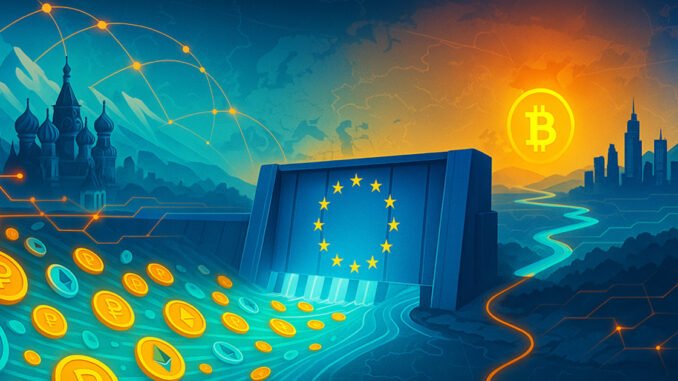
The European Union (EU) is moving to choke off A7A5, the ruble-backed token routing billions through Kyrgyzstan into European crypto markets, but available data suggests the sanctioned flow represents just 2.37% of the bloc-wide Bitcoin trading volume.
As Bloomberg News reported on Oct. 6, the EU proposed sanctions on A7A5, the stablecoin issued by cross-border payments firm A7 and Russia’s state-owned Promsvyazbank (PSB).
The restrictions will prohibit EU-based entities from engaging in transactions involving the token. The bloc also plans to target several banks in Russia, Belarus, and Central Asia for enabling crypto-related transactions.
A7 is owned by Moldovan banker Ilan Shor and PSB, which the UK, EU, and US sanctioned in 2022 following Russia’s invasion of Ukraine.
Garantex, the Russia-based crypto exchange that helped create A7A5, was sanctioned the same year, while A7 itself was sanctioned in early 2025.
Despite these measures, A7’s operations continue to expand. The firm launched a digital bill of exchange for international settlements through its Kyrgyz subsidiary, allowing holders to receive A7A5 tokens on the Tron network or exchange them for Russian rubles.
Elliptic calculated 41.6 billion A7A5 tokens were in circulation as of Sept. 26, valued at $496 million, with cumulative transaction value reaching $68 billion.
A7A5 dominates ruble-to-crypto rails
The A7 network operates the most prominent route to move rubles into crypto markets.
According to reports, users convert Russian rubles into A7A5 within the A7/Old Vector setup, trade the stablecoin on Kyrgyzstan-registered exchange Grinex, then swap into dollar stablecoins, typically USDT.
The tokens are issued on Ethereum and Tron before routing to recipients, including potentially EU-based virtual asset service providers.
A second pathway runs through Russia-based OTC and peer-to-peer markets into USDT, often facilitated on TRON.
The US sanctioned Netex24 and Bitpapa for operating crypto on-ramps serving sanctioned actors.
Additionally, the largest OTC services provider, Garantex, suspended services after Tether froze wallets holding roughly 2.5 billion rubles in March.
A third channel relies on regional “transit hubs.” Watchdog organizations highlight Kyrgyzstan’s rapidly expanding VASP ecosystem, while Turkish authorities have tightened stablecoin transfer limits to $3,000 daily and $50,000 monthly in response to routing activity through their jurisdiction.
Garantex, Grinex, and A7 connected
According to the US Treasury, Grinex was created by Garantex employees immediately after law enforcement disruptions, with Garantex customer deposits transferred so operations could continue.
Corporate registrations are expected to converge on a late-2024 formation with early-2025 operations.
The Treasury states that A7A5 was created “for Russian customers of A7,” with Old Vector working alongside Garantex in the development of the token.
OFAC designated A7 and two subsidiaries alongside Old Vector, describing A7 as a cross-border settlement platform used for sanctions evasion.
A7A5 and Grinex now represent the primary rails for ruble-to-crypto conversion, replacing earlier infrastructure disrupted by sanctions.
Ruble flow fraction of EU Bitcoin volume
The euro pair with Bitcoin (BTC/EUR) serves as the main trading pair across EU venues. Kaiko’s Europe reports indicate that euro-denominated trading is concentrated on a handful of EU platforms, with BTC/EUR being the most popular euro pair.
Euro volumes surged in 2024, with BTC-EUR’s share of global BTC-fiat trading climbing to roughly 10%.
Outside the euro, only a few national-currency BTC pairs maintain durable liquidity on EU exchanges.
Poland’s Zonda routinely lists BTC/PLN as its most active market. Czech exchange Coinmate operates BTC/CZK markets. These local pairs carry domestic significance but remain small compared to BTC/EUR across the bloc.
Amid this landscape, available public data suggests ruble-linked liquidity represents a modest fraction of European Bitcoin trading.
A Sept. 9 report by the European Securities and Markets Authority shows Bitcoin trading volume on regulated EU venues reached approximately $7.5 trillion in the first half of 2025.
Elliptic’s Sept. 26 analysis found that A7A5 processed $68 billion in on-chain transactions, which is lower than the $89 billion that A7 founder Ilan Shor reported on Sept. 4 during an online speech presented to Russian President Vladimir Putin.
An Oct. 6 report by the Centre for Information Resilience noted that A7’s Sales Department Director stated 6% of the firm’s payments were directed to Europe as of late August.
Applying that 6% figure yields a European-directed flow ranging from $4.08 billion to $5.34 billion, considering Elliptic’s and Shor’s figures.
Even taking the higher estimate, A7A5 flow to Europe represents roughly 0.071% of first-half 2025 EU Bitcoin volume.
However, this calculation captures only the A7A5 rail and excludes older OTC/P2P routes, regional hub activity, and direct Russian exchange flows.
When factoring in these additional channels, which lack comprehensive public data but appear in sanctions designations, total ruble exposure to EU Bitcoin markets likely reaches several times the A7A5 figure alone.
A conservative estimate places the total ruble-to-Bitcoin flow at 2.37% of EU trading volume, suggesting that the sanctioned infrastructure, while significant in absolute terms, operates at the margin of European crypto liquidity rather than at its core.
What EU Sanctions Mean for Bitcoin Markets
The proposed EU sanctions targeting A7A5 aim to sever a specific sanctions-evasion channel rather than address systemic threats to European Bitcoin liquidity.
The 2.37% exposure estimate suggests that blocking ruble stablecoin routes will have a limited immediate impact on block-wide BTC/EUR order books.
The action does signal an intensification of regulatory coordination. The US Treasury, UK government, and now EU authorities have moved in sequence against the A7 network, demonstrating willingness to target crypto infrastructure regardless of jurisdiction.
For market participants, the sanctions create compliance burdens rather than liquidity shocks.
EU-based VASPs must screen for A7A5 exposure and sever ties to designated entities, but the dominance of BTC/EUR pairs on established exchanges insulates mainstream European trading from direct disruption.
The bigger question is whether authorities can sustain enforcement as sanctioned actors migrate to new rails.
Garantex’s March 2025 disruption led directly to Grinex’s creation within days. Unless enforcement targets the underlying demand created by Russian entities’ need to move capital across borders, new channels will emerge as quickly as old ones close.
Mentioned in this article


